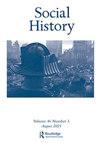英国工业革命期间弃婴学徒的职业分布
IF 1.1
1区 历史学
Q1 HISTORY
引用次数: 0
摘要
本文对伦敦育婴堂(伦敦育婴堂是英国18世纪为孤儿和被遗弃儿童设立的杰出慈善基金会)所安排的学徒制分布进行了新的分析。它探讨了慈善学徒制和教区学徒制之间的异同,在英国工业革命的关键第一阶段,在更广泛的欧洲背景下,提供贫困儿童的劳动力。这一分析的结果表明,弃婴被安置在农业工作,主要是在英格兰北部,以及在伦敦地区的各种小型制造业和零售业。在很短的一段时间里,弃婴女孩被分批送到北部和中部的纺织厂工作,但这种做法很快就被终止了,因为考虑到儿童的福利。育婴堂院长和督察员的广泛资助网络、为处理大量所谓的"一般接待"儿童而设立的省级分院的地点以及对劳动贫困人口生命历程的性别期望是决定将育婴堂儿童送到何处作为学徒以及如何雇用他们的最重要因素。本文章由计算机程序翻译,如有差异,请以英文原文为准。
The occupational distribution of foundling apprentices during the English Industrial Revolution
ABSTRACT This article presents a new analysis of the distribution of apprenticeships brokered by the London Foundling Hospital, England’s pre-eminent charitable foundation in the eighteenth century for orphaned and abandoned children. It explores the similarities and differences between charity apprenticeship and parish apprenticeship systems in supplying pauper children’s labour during the critical first phase of the English Industrial Revolution, within a wider European context. The results of this analysis illustrate that foundling children were set to work in agriculture, mainly in northern England, and in a variety of small manufacturing and retailing industries in the London area. For a short time, foundling girls were sent in batches to work in textile factories in the North and Midlands, but this practice was soon ended over concerns for children’s welfare. The extensive patronage networks of Foundling Hospital Governors and inspectors, the location of provincial branch hospitals set up to cope with the high volume of so-called ‘General Reception’ children, and gendered expectations of the life courses of the labouring poor were the most significant factors in determining where foundling children were sent as apprentices, and how they were employed.
求助全文
通过发布文献求助,成功后即可免费获取论文全文。
去求助
来源期刊

Social History
HISTORY-
CiteScore
1.10
自引率
0.00%
发文量
37
期刊介绍:
For more than thirty years, Social History has published scholarly work of consistently high quality, without restrictions of period or geography. Social History is now minded to develop further the scope of the journal in content and to seek further experiment in terms of format. The editorial object remains unchanged - to enable discussion, to provoke argument, and to create space for criticism and scholarship. In recent years the content of Social History has expanded to include a good deal more European and American work as well as, increasingly, work from and about Africa, South Asia and Latin America.
 求助内容:
求助内容: 应助结果提醒方式:
应助结果提醒方式:


